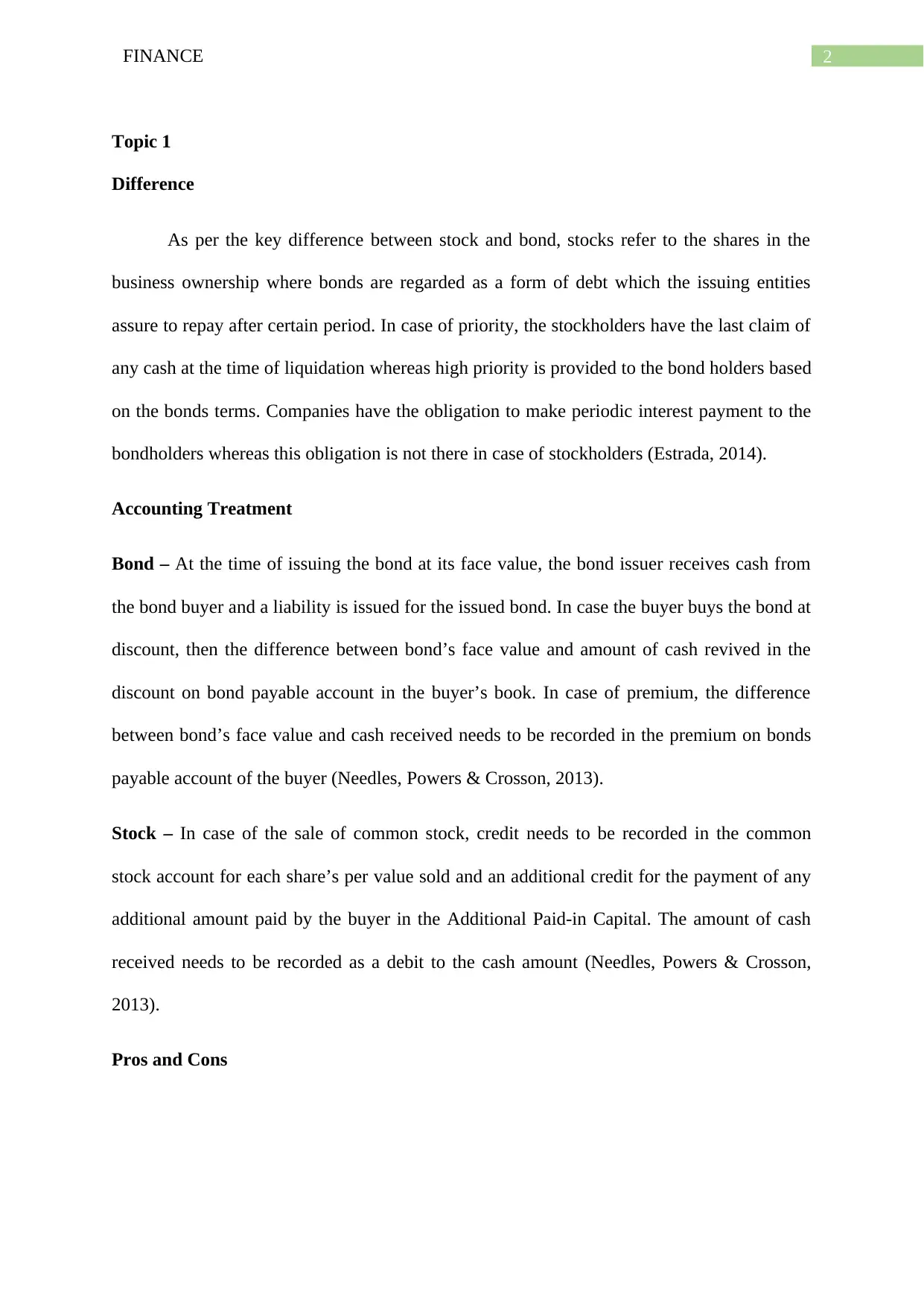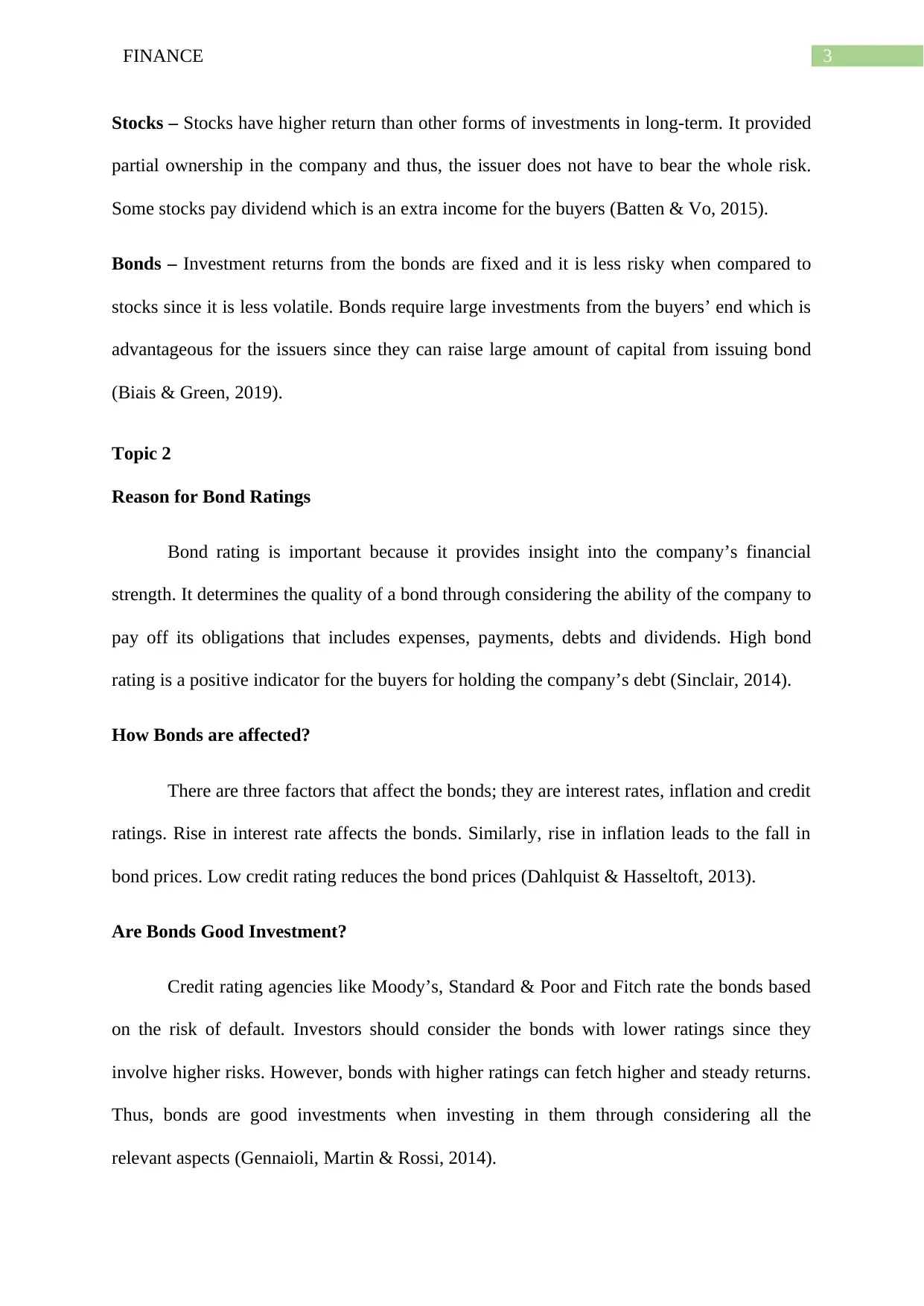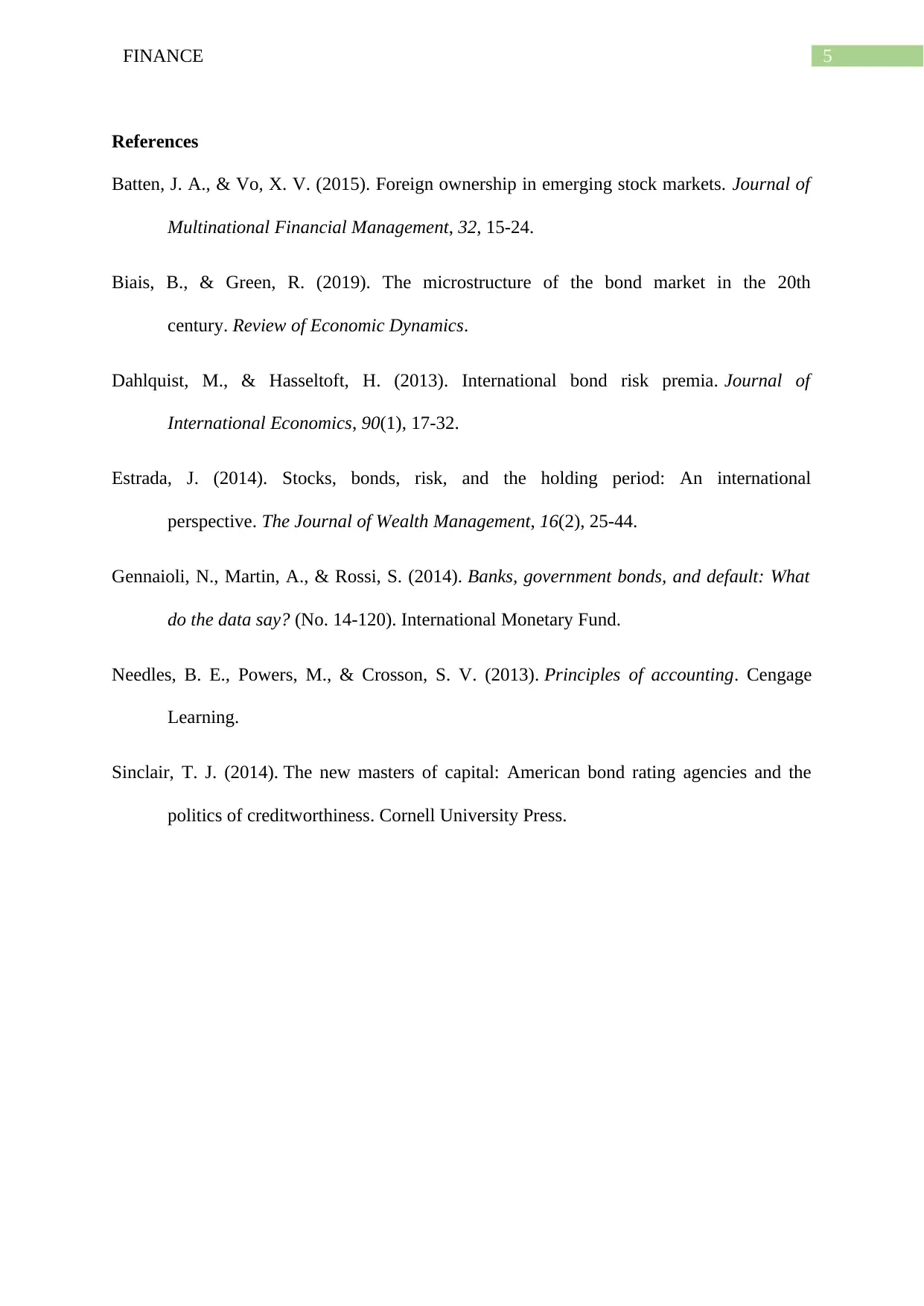Comprehensive Finance Report: Stocks, Bonds, and Investment Analysis
VerifiedAdded on 2022/12/28
|6
|876
|48
Report
AI Summary
This finance report offers a comprehensive analysis of stocks and bonds, exploring their fundamental differences, accounting treatments, and associated pros and cons. The report delves into the concept of bond ratings, explaining their significance in assessing a company's financial strength and their impact on bond prices. It further examines factors influencing bond performance, such as interest rates and inflation, and evaluates the suitability of bonds as investment vehicles. The report provides insights into the risks and returns associated with both stocks and bonds, drawing on academic references to support its findings. Overall, the report aims to provide a clear understanding of these financial instruments and how they function within the broader investment landscape.

Running head: FINANCE
Finance
Name of the Student
Name of the University
Author’s Note
Finance
Name of the Student
Name of the University
Author’s Note
Paraphrase This Document
Need a fresh take? Get an instant paraphrase of this document with our AI Paraphraser

1FINANCE
Table of Contents
Topic 1.......................................................................................................................................2
Topic 2.......................................................................................................................................2
References..................................................................................................................................4
Table of Contents
Topic 1.......................................................................................................................................2
Topic 2.......................................................................................................................................2
References..................................................................................................................................4

2FINANCE
Topic 1
Difference
As per the key difference between stock and bond, stocks refer to the shares in the
business ownership where bonds are regarded as a form of debt which the issuing entities
assure to repay after certain period. In case of priority, the stockholders have the last claim of
any cash at the time of liquidation whereas high priority is provided to the bond holders based
on the bonds terms. Companies have the obligation to make periodic interest payment to the
bondholders whereas this obligation is not there in case of stockholders (Estrada, 2014).
Accounting Treatment
Bond – At the time of issuing the bond at its face value, the bond issuer receives cash from
the bond buyer and a liability is issued for the issued bond. In case the buyer buys the bond at
discount, then the difference between bond’s face value and amount of cash revived in the
discount on bond payable account in the buyer’s book. In case of premium, the difference
between bond’s face value and cash received needs to be recorded in the premium on bonds
payable account of the buyer (Needles, Powers & Crosson, 2013).
Stock – In case of the sale of common stock, credit needs to be recorded in the common
stock account for each share’s per value sold and an additional credit for the payment of any
additional amount paid by the buyer in the Additional Paid-in Capital. The amount of cash
received needs to be recorded as a debit to the cash amount (Needles, Powers & Crosson,
2013).
Pros and Cons
Topic 1
Difference
As per the key difference between stock and bond, stocks refer to the shares in the
business ownership where bonds are regarded as a form of debt which the issuing entities
assure to repay after certain period. In case of priority, the stockholders have the last claim of
any cash at the time of liquidation whereas high priority is provided to the bond holders based
on the bonds terms. Companies have the obligation to make periodic interest payment to the
bondholders whereas this obligation is not there in case of stockholders (Estrada, 2014).
Accounting Treatment
Bond – At the time of issuing the bond at its face value, the bond issuer receives cash from
the bond buyer and a liability is issued for the issued bond. In case the buyer buys the bond at
discount, then the difference between bond’s face value and amount of cash revived in the
discount on bond payable account in the buyer’s book. In case of premium, the difference
between bond’s face value and cash received needs to be recorded in the premium on bonds
payable account of the buyer (Needles, Powers & Crosson, 2013).
Stock – In case of the sale of common stock, credit needs to be recorded in the common
stock account for each share’s per value sold and an additional credit for the payment of any
additional amount paid by the buyer in the Additional Paid-in Capital. The amount of cash
received needs to be recorded as a debit to the cash amount (Needles, Powers & Crosson,
2013).
Pros and Cons
⊘ This is a preview!⊘
Do you want full access?
Subscribe today to unlock all pages.

Trusted by 1+ million students worldwide

3FINANCE
Stocks – Stocks have higher return than other forms of investments in long-term. It provided
partial ownership in the company and thus, the issuer does not have to bear the whole risk.
Some stocks pay dividend which is an extra income for the buyers (Batten & Vo, 2015).
Bonds – Investment returns from the bonds are fixed and it is less risky when compared to
stocks since it is less volatile. Bonds require large investments from the buyers’ end which is
advantageous for the issuers since they can raise large amount of capital from issuing bond
(Biais & Green, 2019).
Topic 2
Reason for Bond Ratings
Bond rating is important because it provides insight into the company’s financial
strength. It determines the quality of a bond through considering the ability of the company to
pay off its obligations that includes expenses, payments, debts and dividends. High bond
rating is a positive indicator for the buyers for holding the company’s debt (Sinclair, 2014).
How Bonds are affected?
There are three factors that affect the bonds; they are interest rates, inflation and credit
ratings. Rise in interest rate affects the bonds. Similarly, rise in inflation leads to the fall in
bond prices. Low credit rating reduces the bond prices (Dahlquist & Hasseltoft, 2013).
Are Bonds Good Investment?
Credit rating agencies like Moody’s, Standard & Poor and Fitch rate the bonds based
on the risk of default. Investors should consider the bonds with lower ratings since they
involve higher risks. However, bonds with higher ratings can fetch higher and steady returns.
Thus, bonds are good investments when investing in them through considering all the
relevant aspects (Gennaioli, Martin & Rossi, 2014).
Stocks – Stocks have higher return than other forms of investments in long-term. It provided
partial ownership in the company and thus, the issuer does not have to bear the whole risk.
Some stocks pay dividend which is an extra income for the buyers (Batten & Vo, 2015).
Bonds – Investment returns from the bonds are fixed and it is less risky when compared to
stocks since it is less volatile. Bonds require large investments from the buyers’ end which is
advantageous for the issuers since they can raise large amount of capital from issuing bond
(Biais & Green, 2019).
Topic 2
Reason for Bond Ratings
Bond rating is important because it provides insight into the company’s financial
strength. It determines the quality of a bond through considering the ability of the company to
pay off its obligations that includes expenses, payments, debts and dividends. High bond
rating is a positive indicator for the buyers for holding the company’s debt (Sinclair, 2014).
How Bonds are affected?
There are three factors that affect the bonds; they are interest rates, inflation and credit
ratings. Rise in interest rate affects the bonds. Similarly, rise in inflation leads to the fall in
bond prices. Low credit rating reduces the bond prices (Dahlquist & Hasseltoft, 2013).
Are Bonds Good Investment?
Credit rating agencies like Moody’s, Standard & Poor and Fitch rate the bonds based
on the risk of default. Investors should consider the bonds with lower ratings since they
involve higher risks. However, bonds with higher ratings can fetch higher and steady returns.
Thus, bonds are good investments when investing in them through considering all the
relevant aspects (Gennaioli, Martin & Rossi, 2014).
Paraphrase This Document
Need a fresh take? Get an instant paraphrase of this document with our AI Paraphraser

4FINANCE

5FINANCE
References
Batten, J. A., & Vo, X. V. (2015). Foreign ownership in emerging stock markets. Journal of
Multinational Financial Management, 32, 15-24.
Biais, B., & Green, R. (2019). The microstructure of the bond market in the 20th
century. Review of Economic Dynamics.
Dahlquist, M., & Hasseltoft, H. (2013). International bond risk premia. Journal of
International Economics, 90(1), 17-32.
Estrada, J. (2014). Stocks, bonds, risk, and the holding period: An international
perspective. The Journal of Wealth Management, 16(2), 25-44.
Gennaioli, N., Martin, A., & Rossi, S. (2014). Banks, government bonds, and default: What
do the data say? (No. 14-120). International Monetary Fund.
Needles, B. E., Powers, M., & Crosson, S. V. (2013). Principles of accounting. Cengage
Learning.
Sinclair, T. J. (2014). The new masters of capital: American bond rating agencies and the
politics of creditworthiness. Cornell University Press.
References
Batten, J. A., & Vo, X. V. (2015). Foreign ownership in emerging stock markets. Journal of
Multinational Financial Management, 32, 15-24.
Biais, B., & Green, R. (2019). The microstructure of the bond market in the 20th
century. Review of Economic Dynamics.
Dahlquist, M., & Hasseltoft, H. (2013). International bond risk premia. Journal of
International Economics, 90(1), 17-32.
Estrada, J. (2014). Stocks, bonds, risk, and the holding period: An international
perspective. The Journal of Wealth Management, 16(2), 25-44.
Gennaioli, N., Martin, A., & Rossi, S. (2014). Banks, government bonds, and default: What
do the data say? (No. 14-120). International Monetary Fund.
Needles, B. E., Powers, M., & Crosson, S. V. (2013). Principles of accounting. Cengage
Learning.
Sinclair, T. J. (2014). The new masters of capital: American bond rating agencies and the
politics of creditworthiness. Cornell University Press.
⊘ This is a preview!⊘
Do you want full access?
Subscribe today to unlock all pages.

Trusted by 1+ million students worldwide
1 out of 6
Related Documents
Your All-in-One AI-Powered Toolkit for Academic Success.
+13062052269
info@desklib.com
Available 24*7 on WhatsApp / Email
![[object Object]](/_next/static/media/star-bottom.7253800d.svg)
Unlock your academic potential
Copyright © 2020–2025 A2Z Services. All Rights Reserved. Developed and managed by ZUCOL.





